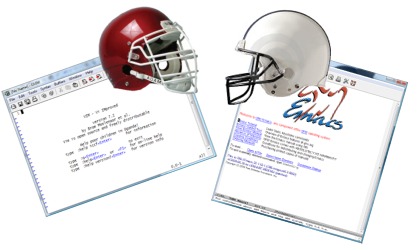
Maybe when (if) I become a Vim and Zsh master, it will make sense …until then I'm using Vim for editing and Zsh in 'Emacs' mode. The solution is simple – just adding bindkey -e to your ~/.zshrc switches the Zsh bindings back to the 'Emacs' mode.Īlthough I really like the separate modes in Vi(m) as the editor, in a shell I find it quite annoying. So what was rendering my usage troublesome was that since I switched to Vim, Zsh switched to 'Vi' mode with the appropriate Vi-like bindings. Emacs is a class of feature-rich text editors, usually characterized by their extensibility. Sure enough pretty soon someone told me that by changing the default text editor Zsh changes its default mode. Since I've switched to Vim and made it my default editor by adding EDITOR="/usr/bin/vim" into my /etc/rc.conf, my shell (the great Z Shell) has started to misbehave.Īfter scratching my head and going really annoyed with why Ctrl+a didn't bring me to the beginning of the line and Ctrl+e to the end of it, but all hell broke loose and then the "delete" and "insert" keys started to change the case of the characters under the cursor and so on, I went to the #zsh channel on and asked. I have not tried it, but it seems like the better implementation. If you are interested in Vim mode in Zsh, I recommend you check out ZVM. I don’t know both Emacs and Vim deeply enough to have a say on which one is better (if there is one that’s better than the other), but this Stack Overflow answer (along with other answers) pointed to me that Emacs is more customizable than Vim, which is, on the other hand, faster and easier to learn. Things done less frequently, like configuring a startup file, are somewhat (or very, depending on how ambitious you are) different. 4.1.While in 2013 I switched my Zsh to Vim mode by default, I never could fully grap its immense power, so I moved to Fish in 2016.
#Emacs vs vi how to
Let’s go over a few basic commands on how to work with Emacs. We can just start typing in the editor directly.

Keep in mind that Emacs doesn’t come with modes. Emacs' was originally published by ITworld.
#Emacs vs vi manual
The manual for the most widely used variant, GNU Emacs, describes it as 'the extensible, customizable, self-documenting, real-time display editor'. The key is represented in short form as ‘E’. If you use vi, you owe it to yourself to learn Emacs if you use Emacs, it wont hurt to learn a little about vi, too. Emacs / i m æ k s /, originally named EMACS (an acronym for 'Editor MACroS'), is a family of text editors that are characterized by their extensibility.

is represented in short form as “C”, while Meta is represented in short form as “M”. Emacs: How to Think About Them And Choose Your Editor by Julian Martinez Medium 500 Apologies, but something went wrong on our end. Most of the commands in emacs start with either with the key or the Meta key (this can be or based on the operating system). The last line is known as a mini buffer that emacs uses to interact with the user. Although Vim keybindings are popular for its ergonomics, the arguably most ergonomical key on a keyboard i.e. At the bottom is the status bar which shows details such as the name of the file and the current cursor location. In Emacs, Vim keybindings are implemented via Evil mode, while in Vim, Emacs keybindings are implemented through the Vimacs package. The top section is the editing section which is also known as the main buffer. To modify files in Linux with emacs editor, we can do: emacs tempFile Unlike vi, Emacs doesnt have interface modes instead, commands are normally control.
#Emacs vs vi install
Sudo yum install emacs # For CentOS / Fedora Manipulating plain ASCII (or, in this internationalized age. Porting Vim Into Emacs One of the primary expedients that Vim users love about Vim is the vast array of key commands. From that point, you have ultimate freedom to make Emacs do whatever you need it to do.

To install emacs, we can use the following commands based on our Linux distribution: sudo apt-get install emacs # For Debian based systems / Ubuntu Emacs provides its own language, Emacs Lisp, which is a Turing complete programming language. At the same time, it has easy-to-remember commands resembling Nano. emacs has features and strengths like Vim. Emacs is one of the oldest and most versatile text editors available in Linux and UNIX based systems.


 0 kommentar(er)
0 kommentar(er)
